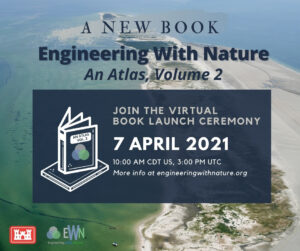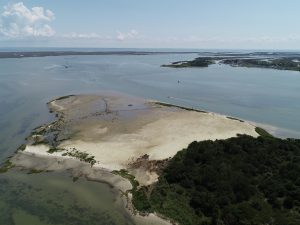 The U.S. Army Corps of Engineers (USACE) Engineering With Nature® Initiative held an international virtual book launch ceremony on April 7, 2021 to celebrate the release of Engineering With Nature: An Atlas, Volume 2. The book showcases 62 projects from around the world that illustrate the principles and practices of Engineering With Nature®. The Swan Island Restoration project, a collaboration between NCCOS, USACE, and partners is one of the featured projects.
The U.S. Army Corps of Engineers (USACE) Engineering With Nature® Initiative held an international virtual book launch ceremony on April 7, 2021 to celebrate the release of Engineering With Nature: An Atlas, Volume 2. The book showcases 62 projects from around the world that illustrate the principles and practices of Engineering With Nature®. The Swan Island Restoration project, a collaboration between NCCOS, USACE, and partners is one of the featured projects.
Engineering With Nature: An Atlas, Volume 2 was developed to communicate the diversity of projects, contexts, and organizations that are advancing worldwide progress in the field, and is preceded by the 2018 publication of the book Engineering With Nature: An Atlas. These projects demonstrate what it means to partner with nature and deliver engineering solutions with a diversity of economic, environmental and social benefits.
The event provided an opportunity to celebrate the release of the book with the public, and included insights from NCCOS Director Dr. Steve Thur, Lt. Gen. Scott A. Spellmon, 55th Chief of Engineers and Commanding General USACE, and other executives and leaders from organizations around the world.
“The last century of coastal development projects were dominated by concrete, rip rap and bulkheads, I firmly believe the next century will be dominated by the use of natural features like marshes, dune systems, oyster reefs, barrier islands and mangroves” said NCCOS Director Dr. Steve Thur.
|
|
|
About the Swan Island Restoration Effort:
At Swan Island, situated in Chesapeake Bay, high rates of shoreline erosion and subsidence have deteriorated the island’s natural habitat and its ability to shelter the nearby town of Ewell, MD from wave energy. Prior to restoration, the low-lying portion of Swan Island consisted of fragmented low marsh in danger of further loss. To reverse this trend and restore the island, USACE Baltimore District placed 60,000 cubic yards of dredged sediments on the island, and planted native salt marsh and dune plants throughout 2019.
Following the restoration effort, researchers from NCCOS, USACE, US Fish and Wildlife Service, and the Maryland Department of Natural Resources continue to measure the hydrodynamic processes and the ecological responses of the island, and to evaluate the impacts and benefits of the project. “Each partner brought their unique expertise to the project resulting in something that none of the participants could have achieved on their own” notes Dr. Thur.
This research directly addresses the perceived uncertainties associated with the performance of nature-based solutions in terms of their ability to reduce waves and erosion, which are often cited as a barrier to implementation. “What we are learning through our research at Swan Island can be used in the design and implementation of projects elsewhere. In my opinion, that is the power of the Engineering With Nature Atlas” said Steve Thur.


